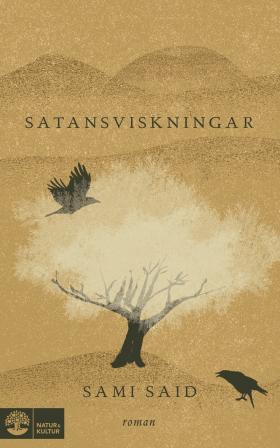
Satansviskningar
(Whispers of Satan)
by Sami Said
reviewed by Sophie Ruthven
Satansviskningar (Whispers of Satan) is Sami Said’s August Prize-nominated fourth novel, and, like a whisper or a desert wind, is hard to pin down. Grand philosophical questions are scattered in careful, elegant language both outside and amongst the pieces of the protagonist Nadine’s interior landscape. The geography is familiar yet unspecific: a dying, poisoned inland sea in combination with the country’s historical status as ‘home of the nomads’ calls to mind Uzbekistan or south Kazakhstan. Though as the author himself is careful to point out, these events take place nowhere in particular. We find ourselves in a nameless, Muslim country, in a time not too far from our own when the world is growing ever drier, and people still live in their old hierarchies of wealth and ladder-climbing. Teenagers try to form their identities at the intersection of the schoolwork they must do, the clubs they must attend, and their own quiet choices of focus, be that sushi or music culture. The sand encroaches.
Nadine’s parents have sent her to the school for troublesome girls, located in the middle of the desert. Her misdemeanour: hiding herself in a wardrobe. She just wants some peace, though she fears the devil is inside her. The school’s dormitories are full of other girls who in various ways have angered or worried their families to the extent that they require a pedagogical reset. In charge of their programme of improvement is the severe Principal, who keeps strict order in the isolated institution and lectures the girls on good, evil and the end of days, at times more in the words of folk belief and her own thoughts, rather than direct quotations from any religious text. Everything seems to be under some kind of control. Yet when the pupils stumble upon news that their heroine, the musician Assam Lo, has been killed in what seems like an honour-based crime, order breaks down and the nature of the group and individual begins to shift. Surrounding all of this is the desert that separates city from countryside, at once a place of fear and solitude.
Difficult not to read symbolically, Whispers of Satan touches on huge themes, and these appear many times over in grand dichotomies throughout the pages of this slim novel. Belief and secularism and how each intersect with the view of the self are paramount as we follow Nadine’s inner journey. Then there’s the contrast between the countryside dwellers and city folk, who seem chiefly to highlight the ails of both tradition and modernity. The pair of men eternally searching for treasure seem to the reader (and the girls) as foolish as the urbanites seeking capital advancement and taking their predictable holidays on the dying inland sea. As well as women’s place amongst men, the individual’s place in the group is put into question. Perhaps being an outsider is essential to survival at times, though it also seems periodically to be a necessary choice to become part of a group. The kind of bond formed in such moments is often unclear, however.
All these bold ideas are impossible to ignore, and yet the narrative passes minimal judgement on them. Unlike the boarding school’s programme, Whispers of Satan does not lecture. Grey areas and ambiguities bleed into the gaps between the characters in their isolation. Is the Principal as unsympathetic as she initially appears? Are Satan’s whispers really just our feelings of isolation and anxiety? And is the desert actually a place of peaceful retreat as opposed to encroaching doom?
This is a novel that demands a certain kind of attention. The language doesn’t wash over you like water or light, it needs care and attention, much as looking for the small plants of the desert does if you are to survive. The characters don’t merely seem distant from one another, but distant from the reader too: I struggled to feel like I was close to Nadine, even though I cared about her. Perhaps that is realistic for many human relationships. The grandness of the concepts — what is evil, what is belonging and who are the outsiders — require a degree of meditation from the reader. It was difficult to get through at times during a busy start to 2024, but by the last page, I was left with the urge to start over and let the words and the desert sit within me again.

Satansviskningar
Natur & Kultur, 2023
280 pages
Foreign rights: Ami Mörén, Natur & Kultur
Nominated for the August Prize for Best Swedish Fiction Book 2023.
Sami Said debuted in 2012 with Väldigt sällan fin (Very Rarely Fine) which won the Catapult Prize and was reviewed in SBR 2013:1. His third novel, Människan är den vackraste staden was reviewed in SBR 2020: 1-2.
